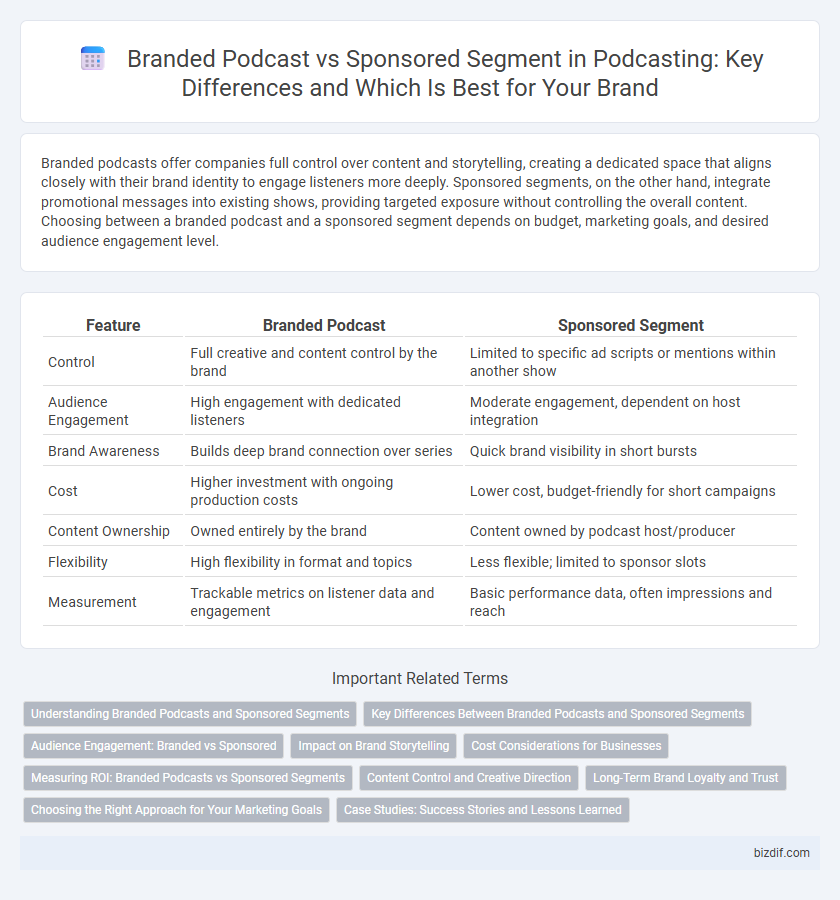Branded podcasts offer companies full control over content and storytelling, creating a dedicated space that aligns closely with their brand identity to engage listeners more deeply. Sponsored segments, on the other hand, integrate promotional messages into existing shows, providing targeted exposure without controlling the overall content. Choosing between a branded podcast and a sponsored segment depends on budget, marketing goals, and desired audience engagement level.
Table of Comparison
| Feature | Branded Podcast | Sponsored Segment |
|---|---|---|
| Control | Full creative and content control by the brand | Limited to specific ad scripts or mentions within another show |
| Audience Engagement | High engagement with dedicated listeners | Moderate engagement, dependent on host integration |
| Brand Awareness | Builds deep brand connection over series | Quick brand visibility in short bursts |
| Cost | Higher investment with ongoing production costs | Lower cost, budget-friendly for short campaigns |
| Content Ownership | Owned entirely by the brand | Content owned by podcast host/producer |
| Flexibility | High flexibility in format and topics | Less flexible; limited to sponsor slots |
| Measurement | Trackable metrics on listener data and engagement | Basic performance data, often impressions and reach |
Understanding Branded Podcasts and Sponsored Segments
Branded podcasts are fully-produced audio series created by a brand to engage audiences with storytelling that aligns closely with the brand's identity, offering deeper connection and sustained audience interaction. Sponsored segments, by contrast, are shorter advertisements or mentions embedded within existing podcasts, providing brands with targeted exposure without full content control. Understanding the differences helps marketers decide between long-term brand-building through branded podcasts or immediate visibility via sponsored segments.
Key Differences Between Branded Podcasts and Sponsored Segments
Branded podcasts are long-form content created by a company to promote its brand through storytelling and immersive experiences, fostering deep audience engagement and loyalty. Sponsored segments are short advertisements or mentions embedded within existing podcasts, designed to deliver targeted brand exposure with less time commitment from the listener. Key differences include content control, with branded podcasts offering full creative authority, while sponsored segments depend on the host's style and reach.
Audience Engagement: Branded vs Sponsored
Branded podcasts foster deeper audience engagement by delivering immersive, consistent storytelling that aligns with the brand's values, creating a loyal listener base. Sponsored segments tend to generate short-term attention but often lack the narrative continuity necessary to build meaningful connections. Audience response metrics typically show higher retention and interaction rates for branded podcasts compared to sponsored content within third-party shows.
Impact on Brand Storytelling
Branded podcasts provide a comprehensive platform for immersive brand storytelling, allowing companies to craft long-form narratives that deeply engage audiences while reflecting core brand values. Sponsored segments, by contrast, offer brief, targeted exposure within existing content, which delivers specific brand messages but often lacks the narrative depth crucial for forging emotional connections. Leveraging branded podcasts enhances authenticity and consistency in storytelling, significantly boosting brand recall and loyalty compared to fragmented sponsored insertions.
Cost Considerations for Businesses
Branded podcasts often require a higher upfront investment due to production, scripting, and ongoing content creation costs, but they offer long-term brand control and deeper audience engagement. Sponsored segments are generally more cost-effective with lower initial expenses, as businesses pay for placement within existing shows without bearing production costs. Companies must weigh budget constraints against marketing goals, deciding between the sustained brand presence of branded podcasts or the targeted, flexible reach of sponsored segments.
Measuring ROI: Branded Podcasts vs Sponsored Segments
Measuring ROI in branded podcasts involves analyzing listener engagement, brand recall, and long-term customer loyalty generated through tailored storytelling and consistent content delivery. Sponsored segments offer immediate impact analysis with clear metrics on campaign reach and direct response rates, but often lack the depth of audience connection found in branded podcasts. Brands seeking sustained ROI should prioritize branded podcasts for comprehensive brand building while leveraging sponsored segments for targeted, short-term promotions.
Content Control and Creative Direction
Branded podcasts offer companies full control over content and creative direction, allowing them to shape narratives aligned with their brand identity and messaging. Sponsored segments provide limited influence, as advertisers typically negotiate short ad spots within existing content, restricting their ability to steer the podcast's overall tone and structure. This distinction impacts how effectively each approach can deliver targeted, coherent brand storytelling to audiences.
Long-Term Brand Loyalty and Trust
Branded podcasts create immersive storytelling experiences that foster long-term brand loyalty through consistent, value-driven content tailored to the target audience. Sponsored segments, while effective for short-term exposure, often lack the depth necessary to build sustained trust and meaningful emotional connections. Investing in branded podcasts enables brands to establish authority and credibility, resulting in stronger consumer relationships over time.
Choosing the Right Approach for Your Marketing Goals
Branded podcasts offer full creative control and deeper storytelling opportunities, ideal for building long-term brand loyalty and engaging niche audiences. Sponsored segments integrate your message within an existing podcast, providing targeted exposure with lower production costs and quicker turnaround. Selecting the right approach depends on your marketing goals, budget, and desired level of audience connection.
Case Studies: Success Stories and Lessons Learned
Branded podcasts like GE's "The Message" demonstrate how immersive storytelling builds deep audience engagement and brand loyalty, driving product awareness through authentic content. Sponsored segments, such as Squarespace in "Serial," effectively target niche demographics by integrating subtle advertising within popular episodes, balancing promotion with listener experience. Success hinges on aligning brand values with podcast content and measuring impact via listener metrics and conversion rates to refine future campaigns.
Branded podcast vs Sponsored segment Infographic

 bizdif.com
bizdif.com